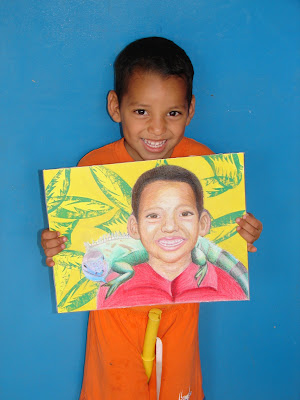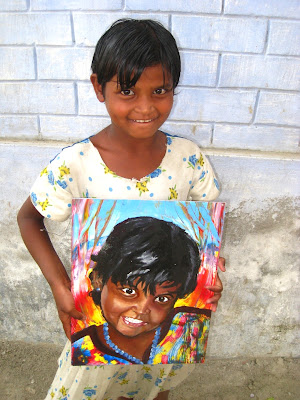I'm so excited to share the work of Ben Schumaker and the Memory Project. We've featured his Hopeful Voices Project - an extraordinary resource that shares essays from youth around the world. The Memory Project is another incredible avenue to share the art work of talented youth - around the world. We were lucky enough to sit down and chat with Ben about the Memory Project - here's what he had to say...
WHAT IS THE MEMORY PROJECT?
Would you like your students’ art to travel the globe? Would your
students enjoy making gifts for some really special kids? If you
teach high school students, check out the Memory Project!
The Memory Project is a unique service-learning initiative in which
advanced high school art students create portraits for children in
orphanages around the world.
To do this, the art students receive pictures of children who are
waiting for portraits, and then work in their art classrooms (or
outside of class) to create the portraits.
Next, the Memory Project staff coordinates the delivery of the
portraits to the children.
The goal of the project is to inspire caring, friendship, and a
positive sense of self. The project is directed by the nonprofit
organization My Class Cares (www.myclasscares.org).
WHAT IS THE PURPOSE?
Given that children who have been abandoned, orphaned, abused, or
neglected usually have few personal keepsakes, the purpose of the
portraits is to provide them with a special memory of their youth, to
honor their heritage and identity, and to help them build a positive
self-image.
Regarding the high school students who make the portraits, this is an
opportunity for them to open their hearts to children who have endured
many hardships, and to promote the value of sharing kindness with
others.
HOW DID IT START?
The project was developed by Ben Schumaker as a graduate student at
the University of Wisconsin.
In 2003, while volunteering in Guatemala, Ben encountered a man who
had grown up in an orphanage. This man explained that he did not have
any personal belongings from his youth. He suggested that Ben help the
kids collect special items that would contribute to their sense of
identity and self-worth.
From this, Ben envisioned that having portraits made by high school
art students would be a way to connect American youth with kids from
other countries in a meaningful exchange of caring. The Memory Project
was officially born in the fall of 2004.
Since then, The Memory Project has been featured on national
television several times, most notably when Katie Couric concluded her
first broadcast of the CBS Evening News with a story about the
project’s success at an orphanage in Nicaragua. The project has also
been covered by major newspapers and magazines throughout the country,
all telling the story of students who have participated.

HOW DO THE KIDS REACT?
The children's immediate reactions to the portraits tend to vary by
age and gender. Young children are most noticeably thrilled to receive
them. They hold their portraits proudly and show them to everyone
around.
Teenagers usually prefer to receive their portraits privately in a
place where their peers are not crowded around to see. While their
immediate reactions are not as easy to assess as the younger
children's, they often display the portraits in their lockers or even
prop them on their pillows.
In general, kids of all ages react most strongly to high quality
portraits that are true to their likeness.
WHAT IS THE PARTICIPATION PROCESS?
1. Art teacher signs up for pictures of children waiting for portraits
and submits the participation fees ($15 per portrait, which is how the
entire project is funded).
2. We mail the teacher 4x6" prints of the kids' photos, instructions
for creating the portraits, and plastic sleeves to protect the
finished portraits. We also email the teacher digital copies of the
photos.
3. The artists then have approximately 3-4 months (or sometimes
longer) to finish the portraits and mail them to us.
4. We then arrange for the portraits to be delivered to the children
along with other portraits for that country.
5. Finally, we are almost always able to send the teacher digital
pictures showing the portraits in the hands of the kids (except for
kids who are no longer at the orphanage).

WHAT IF MY SCHOOL CAN'T AFFORD THE PARTICIPATION FEES?
If your budget is tight, consider the following funding ideas:
- To help your artists raise $15 each, we are happy to provide a
sponsorship letter (www.thememoryproject.org/sponsors.doc) that
students can present to anyone interested in sponsoring their work. In
exchange, the student can write the sponsor's name on back of the
portrait.
- Consider approaching a local service organization such as Rotary or
Kiwanis. Members of such groups are very eager to support young
people who are engaged in service.
- Form a partnership with a local bank, grocery store, or other
business. The business would pay the participation fees, and then the
finished portraits would go on display at the business before they are
due to be sent to us. Customers would appreciate that the business is
supporting local service activities.
- Have someone lend money for the fees in order to get the group
started. Later, hold a gallery exhibit of the finished portraits and
invite donations (which will then reimburse the person who made the
loan).
HOW CAN I GET MY STUDENTS INVOLVED?
If you are interested in participating with your advanced high school
students, please visit www.thememoryproject.org!
All photos courtesy and copyright of The Memory Project

